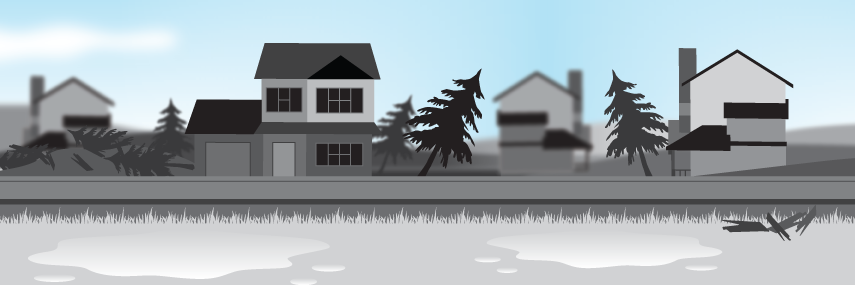Recovering after a flood

Returning home after widespread flooding can be overwhelming. Use caution and take it one step at a time.
On this page
Returning home
Consider creating a cleanup and recovery plan. Just like having an emergency plan, it will help you organize what needs to be done to return your home to normal.
Tips for returning home:
- Do not return home until authorities say it is safe to do so and they have cleared your home of any structural, electrical or other hazards
- Stay out of any buildings if floodwaters remain around or in the building
- Do not enter if you see any buckled walls or floors
- Check for any damage to electrical or gas equipment that may have been caused by floodwater. Don’t turn anything back on until the equipment has been inspected by a licensed gas or electrical contractor. Find one using Technical Safety BC’s find a licensed contractor tool
- If any damage caused requires you to dig during cleanup, BC 1 Call is a free service that provides what infrastructure lies beneath your property. Before you dig, it is crucial to visit the website or call 1-800-474-6886
- If water needs to be drained, do so slowly addressing about 1/3 of the water per day. This ensures the structure of your home won’t buckle
- Do not heat your home above the temperature outside until all water has been removed.
Managing mould and health risks
Cleaning up after a flood can pose health risks. You may see or smell mould on clothing, drywall, furniture, cardboard boxes or books, but it may also be hidden under or behind items like carpet, cushions or walls.
Mould grows in wet and damp conditions. It’s less likely to grow if your home and furnishings are dry within 48 hours after a flood. This will help prevent mould, which can continue to damage your home long after.
Pregnant women, children, the elderly, pets and those with asthma, allergies or other health problems should not be in or near the area where the mould is being cleaned up.
Identify all mouldy items. Place and seal items in a plastic bag and dispose it. It’s important to wash your hands thoroughly after mould cleanup, as well as change your clothes.
If you rent your home, speak to your landlord about any moisture or mould problems. It may be the responsibility of the owner or landlord to address the problem. If you own a condo unit or workspace, be sure to consult with the Condominium Board before taking any action.
Consider seeking professional assistance to identify the right corrective actions to be taken inside your home.
Tip: Before you start your cleanup activities, call your insurance representative or company. Most insurers have a 24-hour claims service.
How to clean your home
Before you begin cleaning, open all interior and exterior doors and windows, allowing air to flow freely through the space. Do not use fans if mould is present, as this can spread the mould to new areas.
Mould that comes back after cleaning is usually an indication that the source of moisture has not been removed. If this happens, always seek professional assistance.
Scrub all washable surfaces with a household bleach solution or unscented soap solution. These areas include window sills, concrete surfaces, hard surfaces and tiles. Dry the surfaces quickly.
Painting or caulking over mouldy surfaces like drywall does not kill mould or stop it from growing back. If the mould is underneath the paint, the drywall will need to be removed and replaced.
Essential items for cleaning mould
- Bucket
- Stiff bristle brush
- Cleaning clothes
- Goggles
- Protective rubber gloves
- Waterproof rubber boots
- Dish detergent
- Household bleach
- N-95 respirators, or ones that provide more protection
Cleaning solutions
- A bleach solution is made up of 1-part bleach to 10-parts clean water
- You can make a baking soda solution by adding a ¼ tablespoon of baking soda to a spray bottle of warm water
- A soap solution can be made by combining unscented detergent and warm water
What to discard
Mould cannot be properly cleaned from many porous materials. Instead, dispose of materials that cannot be dried within 48 hours.
Remove and discard flooring that has been soaked by flood water. Remove all wet drywall, going at least 30 cm above the flood water level.
Dispose of all wet items that do not dry quickly, including:
- Insulation and drywall
- Carpets
- Particleboard furniture
- Mattresses and box springs
- Stuffed toys
- Paper and cardboard products
- Pillows and cushions
- Furniture coverings
- Perishable foods, foods or medicines packaged in cardboard or plastic
Make an insurance claim
Before you start your cleanup activities, call your insurance representative or company. Most insurers have a 24-hour claims service. Be as detailed as possible when providing information.
List all damaged or destroyed items. If possible, assemble proofs of purchase, photos, receipts and warranties. Take photos of the damage. Keep all receipts related to clean up and living expenses if you’ve been displaced. Ask your insurance representative about what expenses you may be entitled to and for how long.
If you do not know the name of your insurer or your insurance representative, contact Insurance Bureau of Canada’s Consumer Information Centre at 1-844-227-5422. Read more about insurance and emergency preparedness.
Psychological care
Learn how to stay safe and healthy in an emergency.
